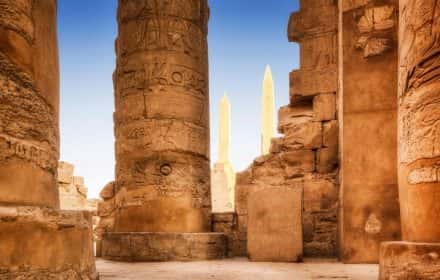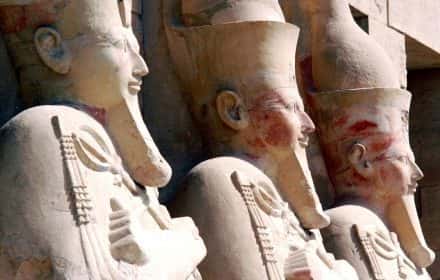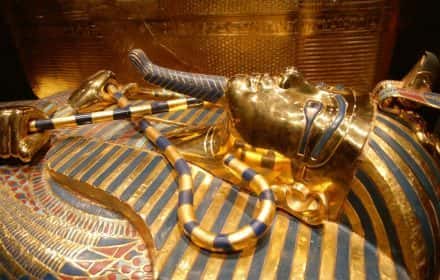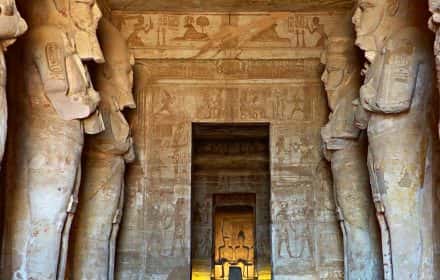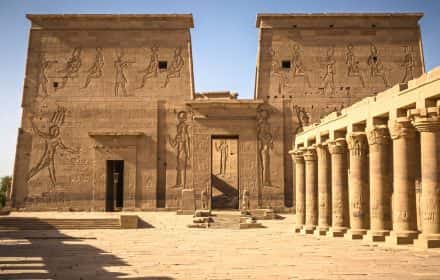This site uses affiliate links, meaning that if you make a purchase through our links, we may earn an affiliate commission.
In the heart of southern Egypt, along the banks of the legendary Nile River, stands an extraordinary testament to human ingenuity and devotion: the Temple of Horus at Edfu.
This ancient marvel, devoted to the falcon-headed god Horus, stands as one of Egypt’s most impeccably preserved temples, showcasing the zenith of Ptolemaic architectural prowess.
Our journey today invites you to unlock the secrets concealed within the Temple of Horus. This blog post will serve as your compass, directing you to five captivating sights that demand your attention during your visit to Edfu.
From towering pylons to meticulously etched hieroglyphics, every corner of this temple narrates a tale of Egypt’s splendor and spiritual dedication. So, without further ado, let’s embark on a spellbinding expedition through the Temple of Horus, where the echoes of history resonate through every stone and inscription.
- 1. Most Efficient Ways of Reaching the Temple of Horus at Edfu
- 2. Essential Insights into the Temple of Horus at Edfu
- 3. The Rediscovery of the Temple of Horus at Edfu: Unearthing Ancient Splendors
- 4. Map of the Temple of Horus at Edfu
- 5. What to See at the Temple of Horus at Edfu - 5 Amazing Things You Can't Miss
-
- 5.1. The Pylon
- 5.2. The Courtyard
- 5.3. The Great Hypostyle Hall (Outer Hall)
- 5.4. The Inner Hypostyle Hall
- 5.5. The Naos
Most Efficient Ways of Reaching the Temple of Horus at Edfu
The Temple of Horus at Edfu is located 109 km south of Luxor. It roughly takes 2 hours and 15 minutes to reach the city of Edfu.
Image Source: Map data ©2020 ORION-ME
The best way to visit the Temple of Horus at Edfu is with a private guide and a driver. Honestly, having a driver and a tour guide gives you total flexibility. You can decide how long you will stay and what you want to see.
Now, if you are staying in one of the hotels in Luxor, your hotel will be more than happy to arrange for you a driver and a guide. Needless to say, this is an expensive option, but it is all worth it.
Another option is to join a tour. You can ask your hotel for a bus tour that goes to Edfu. It is probably one of the least expensive options. But, it does not give you much flexibility.
Another option is to just book a taxi and visit Hours Temple of Edfu. You will always be able to hire a guide right at the entrance to the temple.
Essential Insights into the Temple of Horus at Edfu
Edfu, a city renowned for its historical significance, boasts a magnificent sandstone temple dedicated to the revered falcon-headed deity, Horus. This temple, known as the Temple of Horus at Edfu, stands as a remarkable testament to ancient Egyptian architecture and spirituality.
Constructed during the Ptolemaic Period, the Temple of Horus’s origins date back to 237 BC when it was initiated under the patronage of Ptolemy III Euergetes. This awe-inspiring architectural endeavor was not completed until approximately 180 years later, around 57 BC, during the reign of Ptolemy XII Auletes.
Such an extended construction period underscores the meticulous craftsmanship and dedication invested in this sacred edifice.
What sets the Temple of Horus at Edfu apart is its unparalleled state of preservation. Among the ancient temples scattered throughout Egypt, this temple reigns as the most complete and best-preserved structure. It offers modern-day visitors a unique glimpse into the architectural splendor and religious fervor of the time.
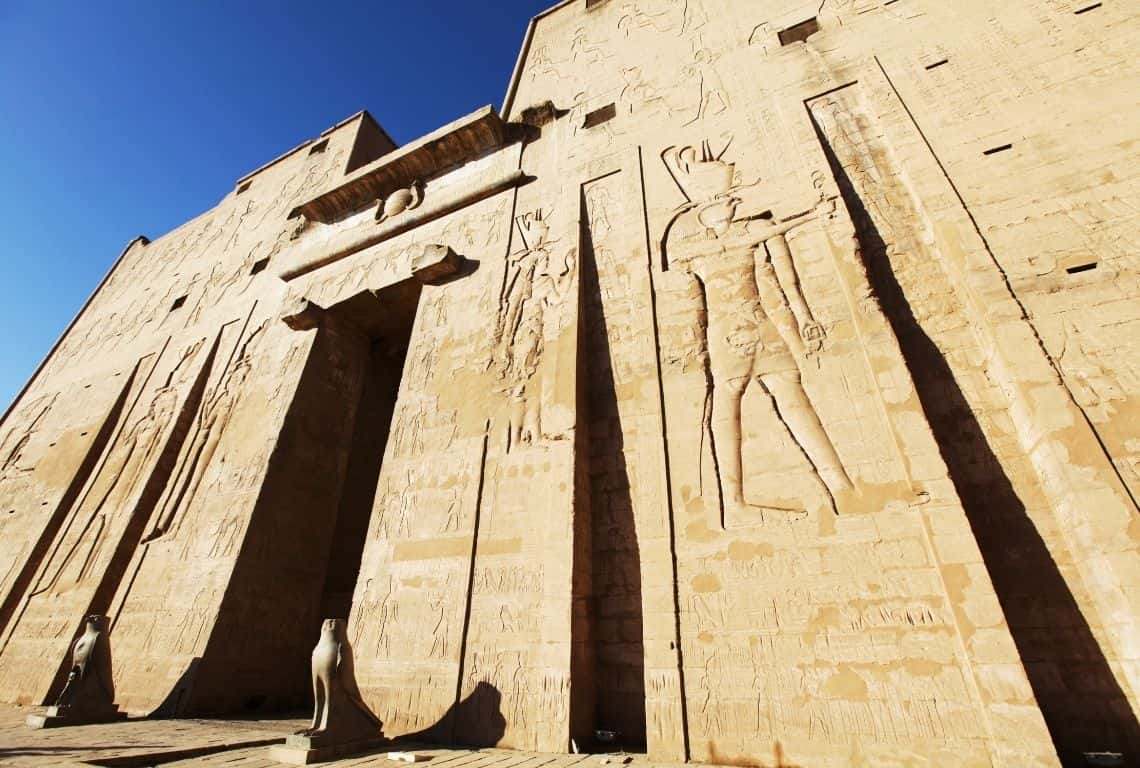
The entrance to the Temple of Horus at Edfu / What to See at the Temple of Horus at Edfu
One intriguing belief associated with the temple is its supposed location atop the very ground where the legendary battle between Horus and Seth transpired. This mythological connection imbues the site with an aura of profound significance, inviting contemplation of the ancient Egyptian worldview and the enduring tales that shaped their culture.
Horus, often depicted as a majestic falcon or a falcon-headed man, held a special place in the hearts of the Edfu inhabitants. Here, he was venerated as the falcon Horus of Behdet, embodying the deity’s multifaceted nature and symbolizing protection, divine power, and the eternal struggle against chaos.
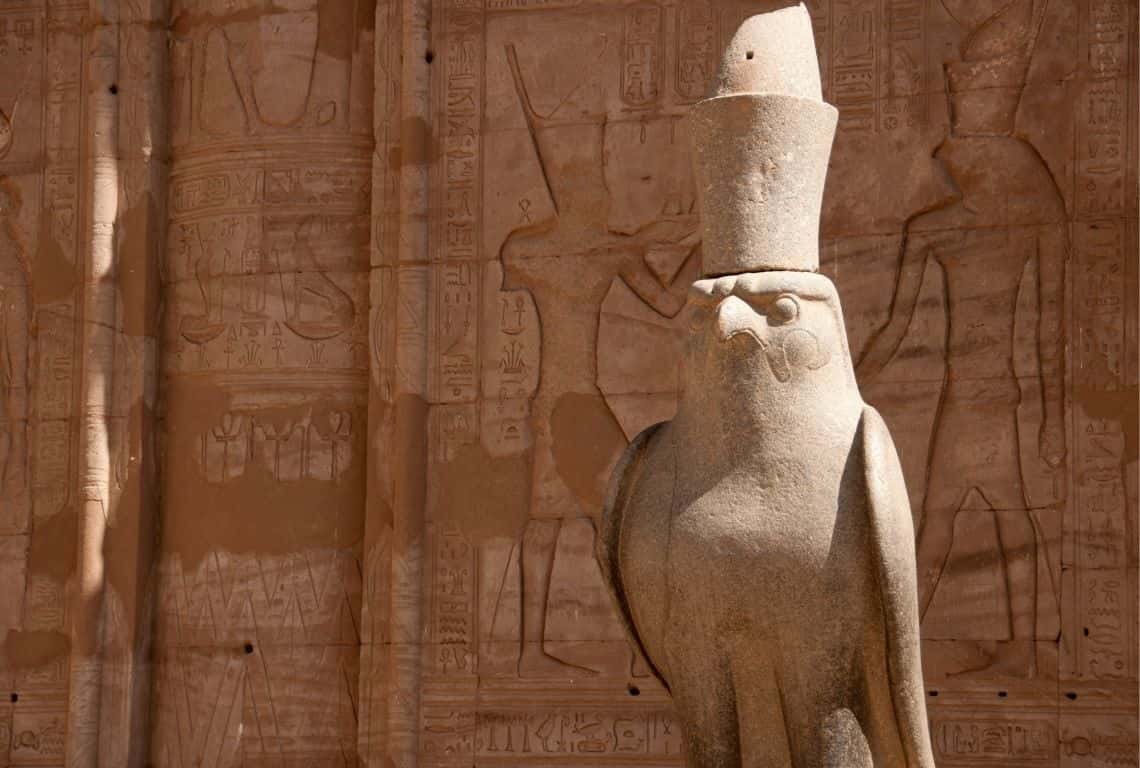
Horus was usually depicted as a falcon or as a falcon-headed man. At Edfu, Horus was worshiped as the falcon Horus of Behdet / What to See at the Temple of Horus at Edfu
As you explore the Temple of Horus at Edfu, you will embark on a journey through time, delving into the depths of ancient Egyptian spirituality and the architectural marvels that continue to captivate and inspire visitors to this day.
The Rediscovery of the Temple of Horus at Edfu: Unearthing Ancient Splendors
The Temple of Horus at Edfu saw its days as a place of worship come to an end due to the far-reaching effects of history.
In the year 391 AD, Theodosius I issued an edict that banned non-Christian religious practices within the vast Roman Empire. Consequently, this sacred sanctuary, once a hub of devotion, fell silent, and its spiritual significance diminished.
As the centuries rolled on, the sands of time and desert encroachment conspired to conceal the temple from sight. Layer by layer, the temple became buried beneath the relentless desert sands, a silent witness to the passage of time.
Surprisingly, the temple’s story took an unexpected turn as local inhabitants erected their homes directly over the ancient temple grounds. Life went on above the hidden ruins, oblivious to the ancient treasures buried beneath their feet.
It wasn’t until the year 1798, during the era of the French expedition, that the temple’s slumbering secrets were stirred once more.
Yet, it wasn’t until 1860 that Auguste Mariette embarked on the monumental task of unearthing the Temple of Horus at Edfu. Through his tireless efforts, the temple reemerged from its sandy cocoon, allowing the world to once again marvel at the architectural and spiritual splendor that lay hidden for centuries beneath the desert’s embrace.
Map of the Temple of Horus at Edfu
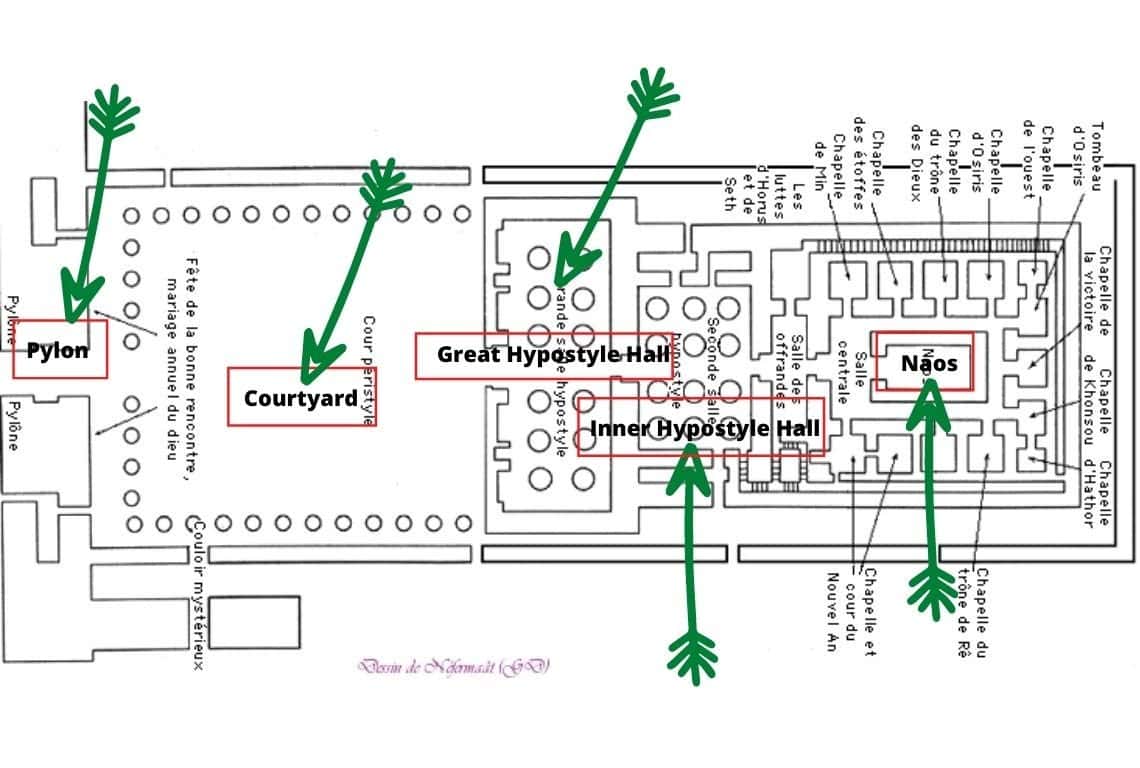
Map of the Temple of Horus at Edfu / Image Credit: Wikimedia Commons
What to See at the Temple of Horus at Edfu - 5 Amazing Things You Can't Miss
The Pylon
Standing proudly at a towering height of 130 feet, the entrance to the Temple of Horus at Edfu is framed by a grandiose pylon, a term derived from the Greek language that denotes the monumental gateway of an Egyptian temple.
This monumental structure comprises two soaring towers, each crowned with a distinctive cornice, united by a lower section that envelops the entrance between them.
Typically, the entrance itself would reach approximately half the elevation of the towering pylons, creating a visually striking effect that emphasized the temple’s grandeur.
Delving into the historical imagery of these pylons, contemporary depictions reveal them adorned with long poles, and fluttering banners in the wind, adding an additional layer of splendor to the temple’s façade.
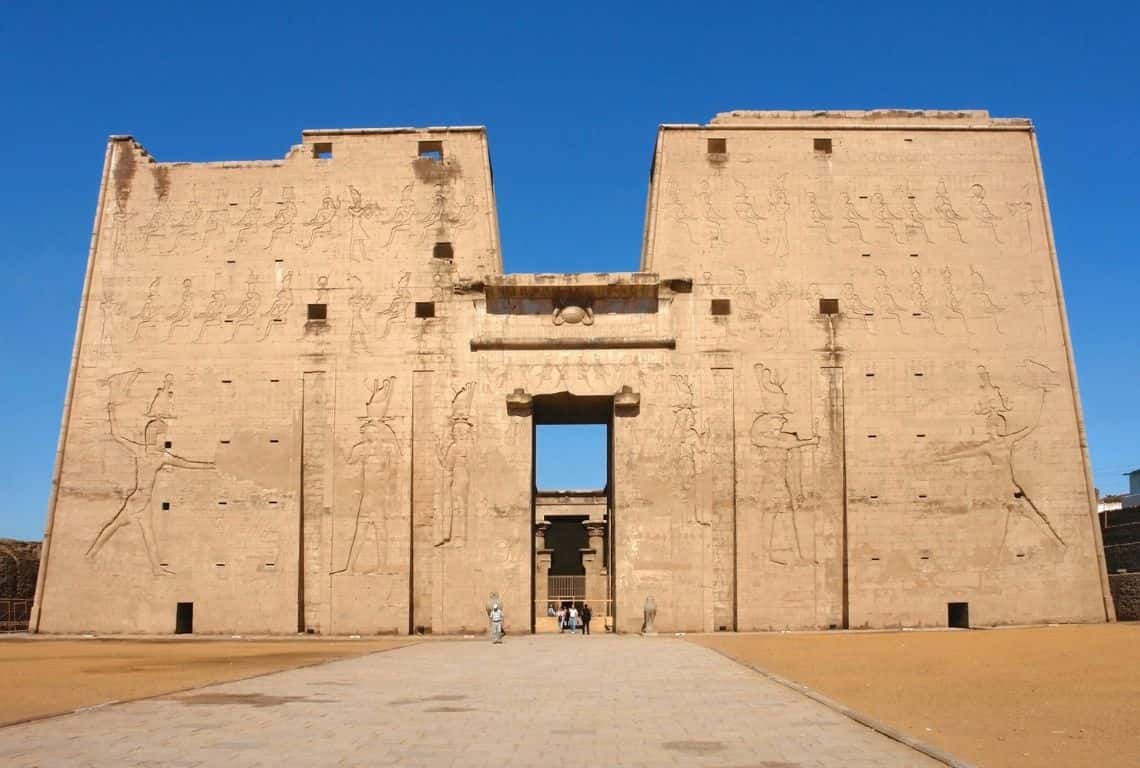
The Pylon at the Temple of Horus at Edfu / What to See at the Temple of Horus at Edfu
However, it is the captivating reliefs adorning these twin towers that steal the show. These intricate carvings, mirroring each other in perfect symmetry, portray the triumphant pharaoh Ptolemy XII in the act of defeating his adversaries.
These reliefs not only serve as a testament to the might and valor of the pharaoh but also provide invaluable insights into the historical narratives and cultural significance of the time.
Intriguingly, on each side of these towering pylons, you will notice four sizable openings, believed to have potentially served as anchoring points for flags or banners that would have fluttered in the Egyptian breeze, adding a dynamic and ceremonial touch to the temple’s exterior.
To further guard and grace the temple’s entrance, two formidable granite statues of Horus, in his falcon form, stand as sentinels, symbolizing protection and divine guardianship.
These statues, with their imposing presence, serve as a fitting prelude to the enchanting world that awaits within the Temple of Horus at Edfu!
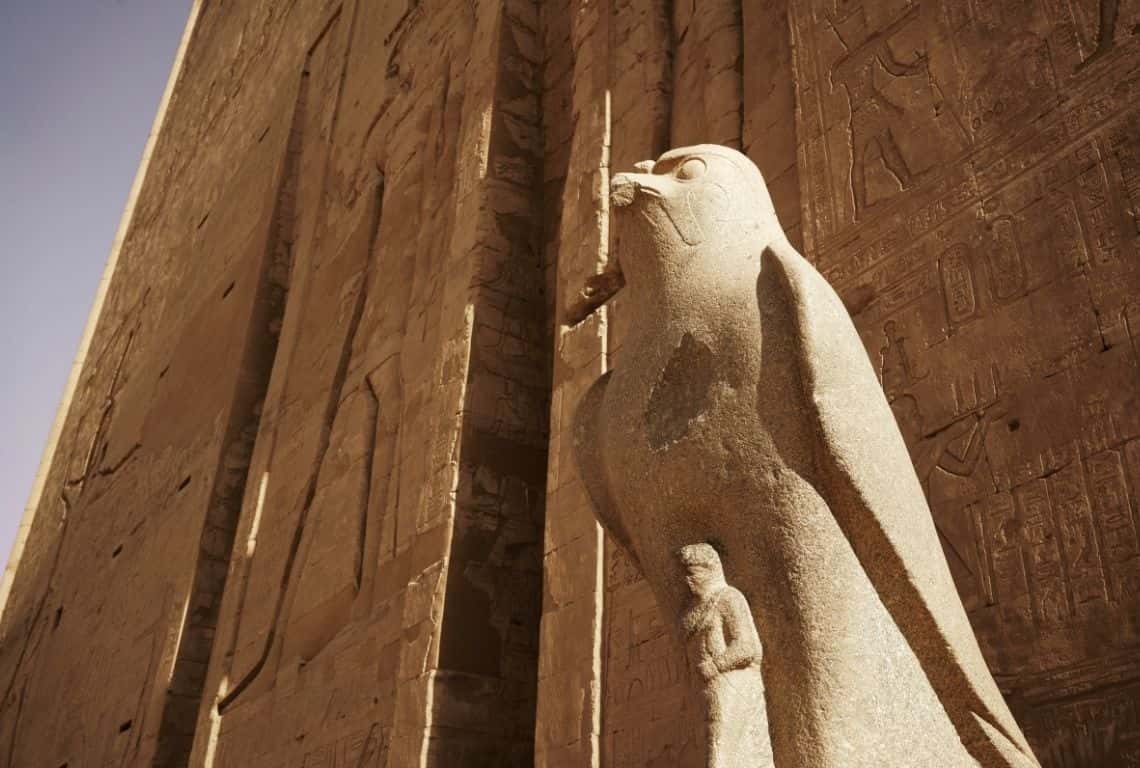
The entrance to the Temple of Horus at Edfu is guarded by two amazing granite statues of Horus as a falcon / What to See at the Temple of Horus at Edfu
The Courtyard
As you step beyond the temple’s entrance gate, be sure to cast a glance back at the rear side of the imposing pylon. Here, you will find a captivating tableau of reliefs that narrate the story of the “Happy Reunion” feast, a significant event in which Horus of Edfu and Hathor of Dendera were joyfully united.
This celestial union was a momentous occasion celebrated not once, but twice each year.
First, the grand festivities took place at the Temple of Edfu, an event steeped in religious and cultural significance. Then, the jubilation echoed once more within the sacred precincts of the Dendera Temple, underscoring the profound connections between these two powerful deities and their respective temples.
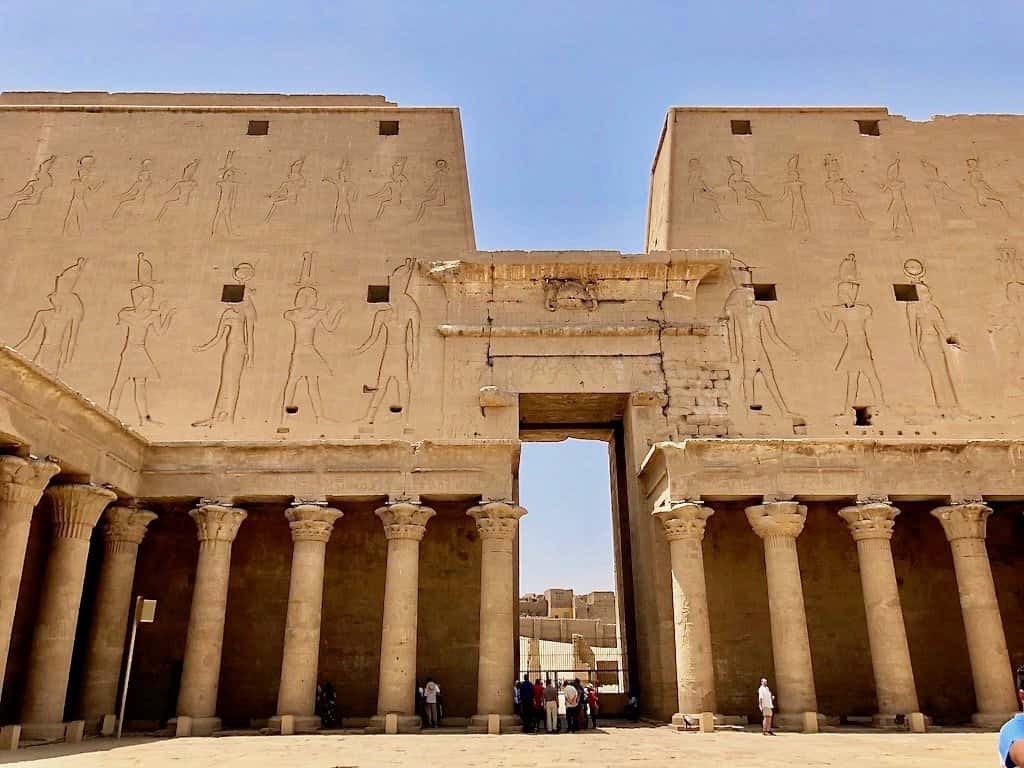
The back side of the pylon has some impressive reliefs depicting the Happy Reunion feast, in which Horus of Edfu is united with Hathor of Dendera / What to See at the Temple of Horus at Edfu
The courtyard, your next stop on this captivating journey, envelops you on three sides with a covered colonnade, boasting an impressive array of thirty-two stately columns.
These intricately carved pillars not only provide structural support but also serve as a testament to the architectural prowess of the time.
As you wander through this awe-inspiring colonnade, you will find yourself transported to an era when craftsmanship and artistry converged to create spaces of immense beauty and cultural significance.
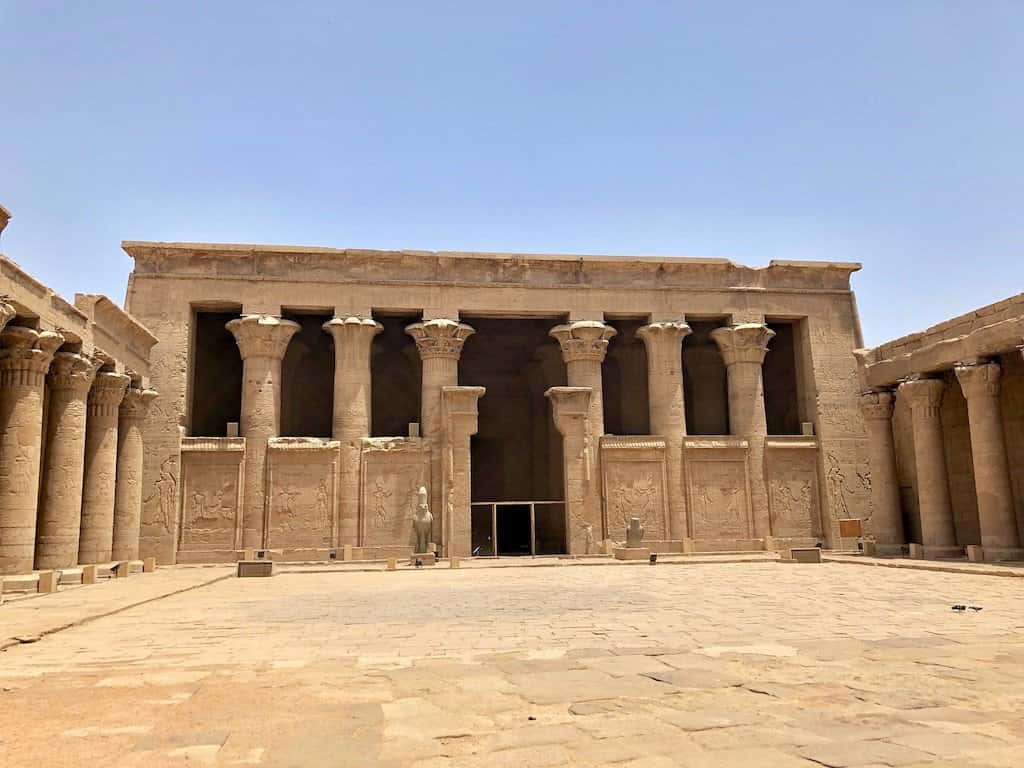
The Courtyard at the Temple of Horus at Edfu / What to See at the Temple of Horus at Edfu
As you draw closer to the entrance of the Great Hypostyle Hall, take a moment to appreciate the granite statues of Horus depicted in his formidable falcon form.
While one of these statues has regrettably succumbed to the ravages of time, the other stands proudly, exquisitely preserved, offering a glimpse into the enduring symbolism of protection and divinity associated with Horus.
These statues serve as guardians, both to the temple and to the rich tapestry of history woven into the very fabric of the Temple of Horus at Edfu.
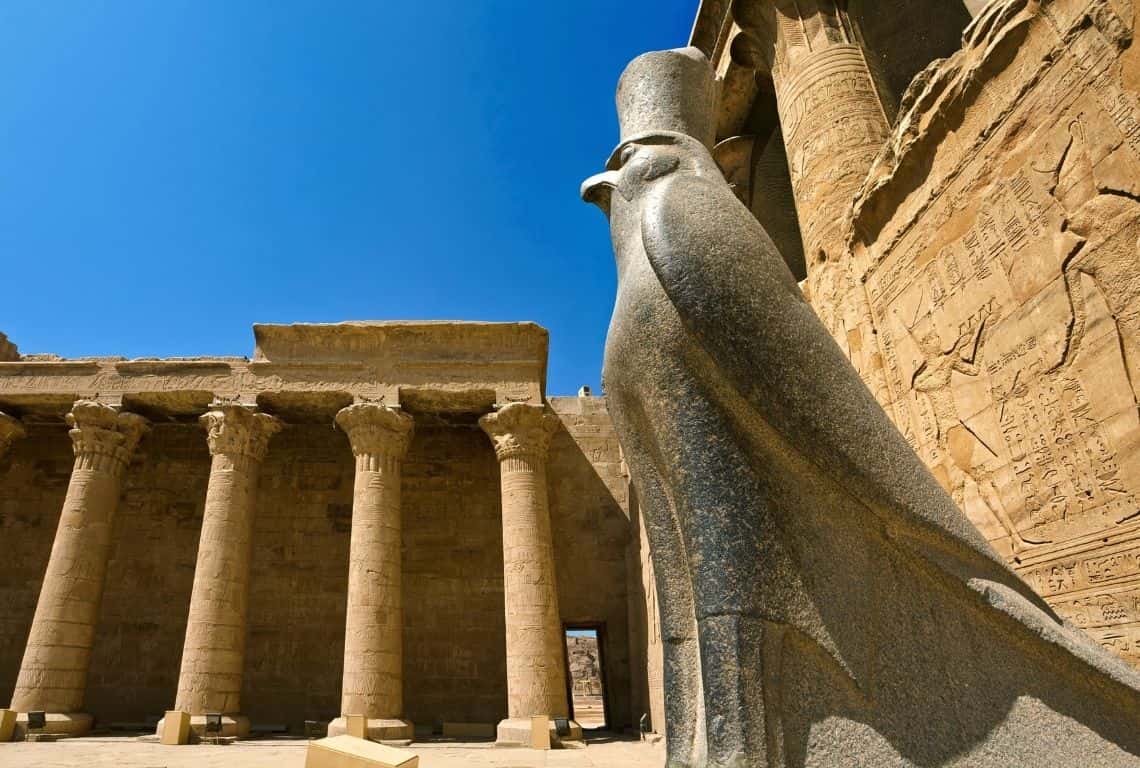
Statue of Horus as falcon guarding the entrance to Hypostyle Hall at the Temple of Horus at Edfu / What to See at the Temple of Horus at Edfu
The Great Hypostyle Hall (Outer Hall)
Behold the awe-inspiring Great Hypostyle Hall, a grand chamber that beckons you beyond the confines of the courtyard!
This majestic Outer Hall, a true testament to ancient architectural ingenuity, welcomes you with open arms. Comprising twelve towering columns thoughtfully arranged in two impressive rows, it is a space that defies both scale and expectation.
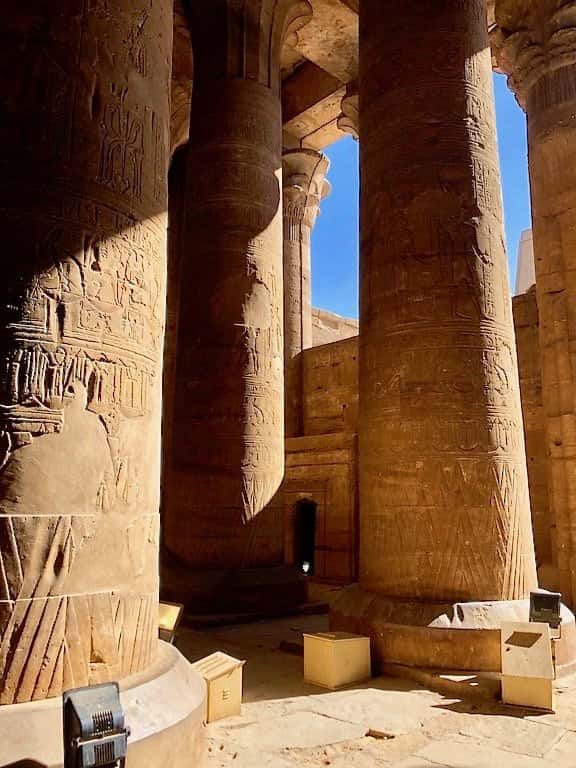
The Great Hypostyle Hall (Outer Hall) / What to See at the Temple of Horus at Edfu
As you step foot into the Great Hypostyle Hall, prepare to be utterly amazed by the sheer magnitude of this monumental chamber.
Its vastness is a testament to the grand ambitions of those who crafted it, leaving visitors in a state of reverent admiration for the skill and vision of ancient architects.
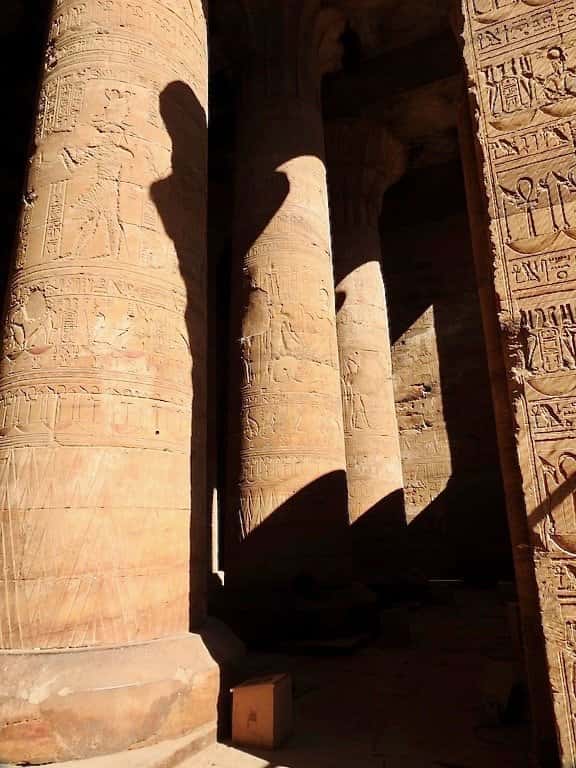
The Great Hypostyle Hall (Outer Hall) / What to See at the Temple of Horus at Edfu
While traversing the length of the Great Hypostyle Hall, be sure to cast your gaze upwards. Here, a visual treasure awaits your discovery!
The hall’s ceiling, adorned with intricate astronomical imagery, unfolds like a celestial tapestry overhead.
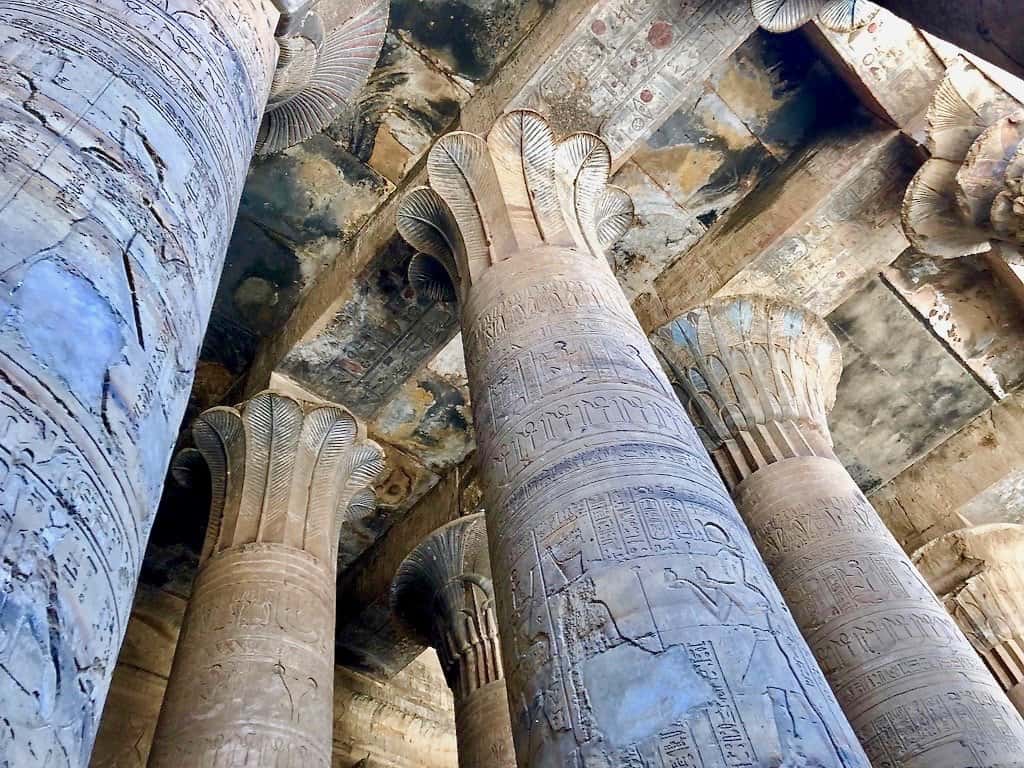
Beautiful floral capitals and the ceiling are adorned with astronomical imagery / What to See at the Temple of Horus at Edfu
Allow yourself to be captivated by the celestial wonders that grace this celestial canvas, and marvel at the meticulous craftsmanship that brought these cosmic visions to life.
Additionally, take note of the remarkable floral capitals crowning the columns, each a unique work of art in its own right. These exquisite details offer glimpses into the profound symbolism and artistic sophistication that defined the Temple of Horus at Edfu, enriching your journey through this hallowed space.
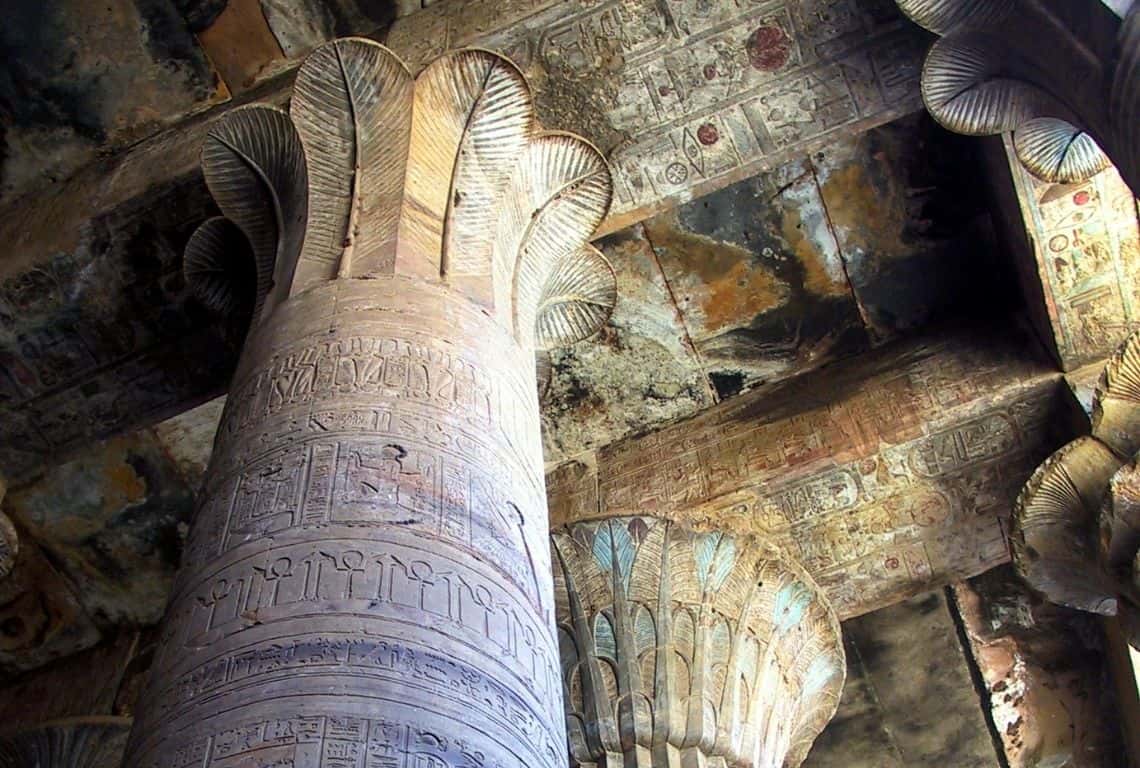
Foral capitals and the ceiling adorned with astronomical imagery / What to See at the Temple of Horus at Edfu
The Inner Hypostyle Hall
Transitioning from the grandeur of the Outer Hypostyle Hall, you will find yourself standing before the entrance to the Inner Hypostyle Hall, a smaller yet equally mesmerizing chamber that reveals even more profound treasures within the Temple of Horus at Edfu.
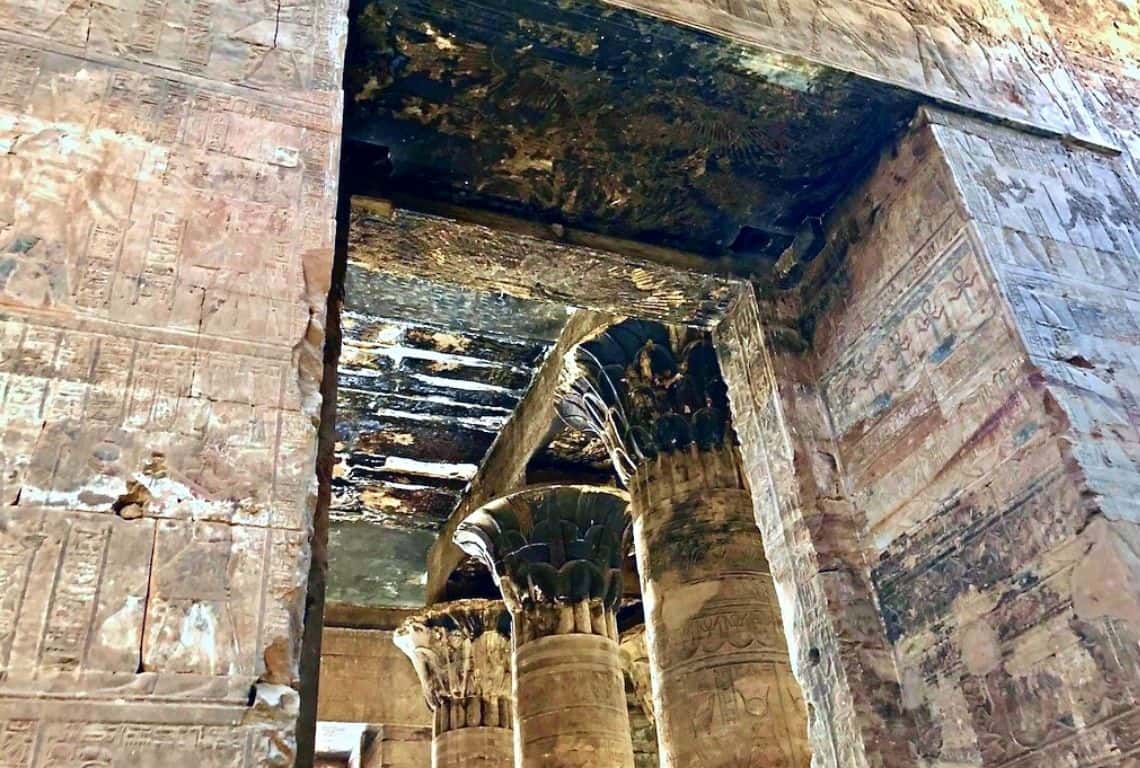
The Inner Hypostyle Hall is smaller, however, it is even more impressive than the first hall / What to See at the Temple of Horus at Edfu
This inner sanctum is graced by a dozen columns, thoughtfully arranged in three rows, inviting you to venture deeper into the temple’s heart.
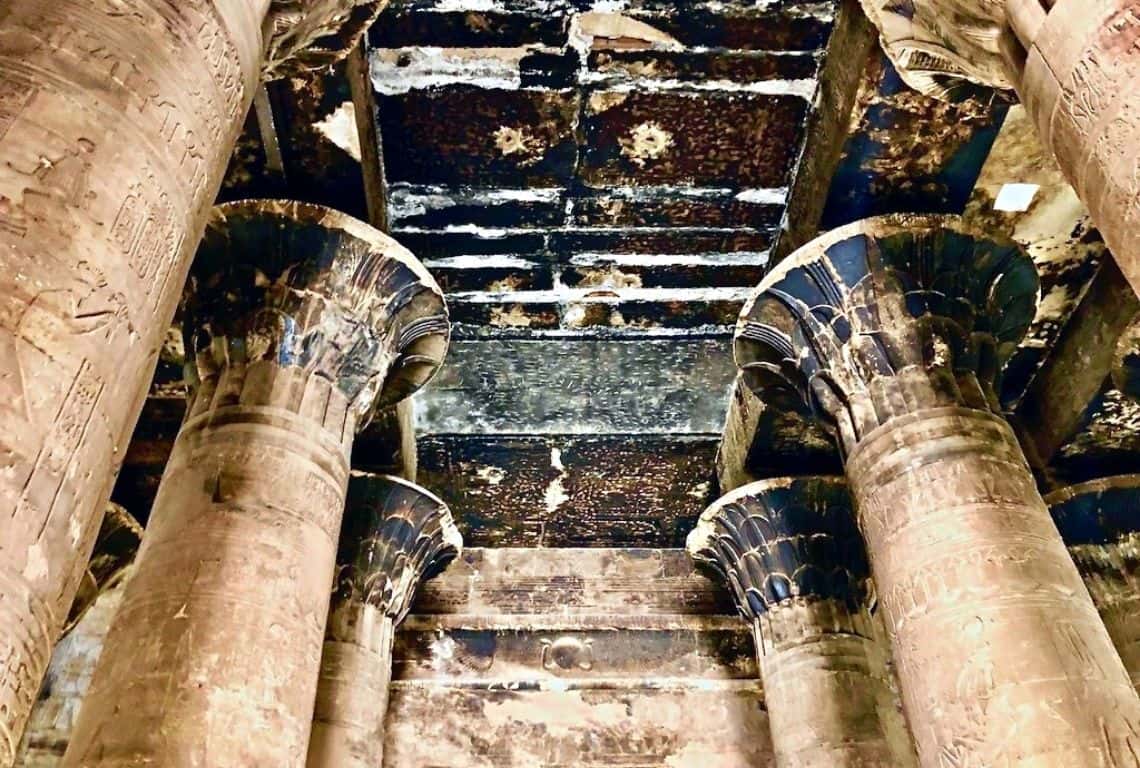
The Inner Hypostyle Hall / What to See at the Temple of Horus at Edfu
As you step inside, you will notice that the ambient light diminishes, creating a captivating play of illumination upon the columns.
Colorful lights gracefully dance upon the stone, enhancing the mystical ambiance of this sacred space.
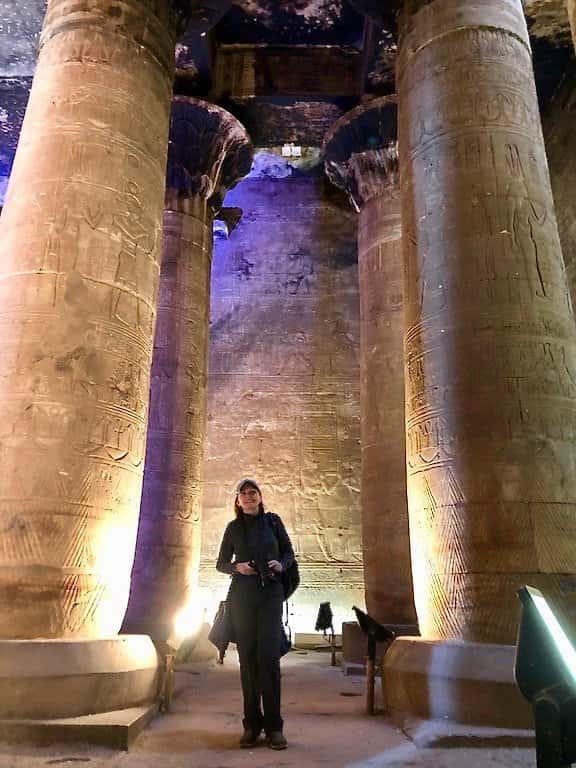
The columns are beautifully illuminated with different color lights / What to See at the Temple of Horus at Edfu
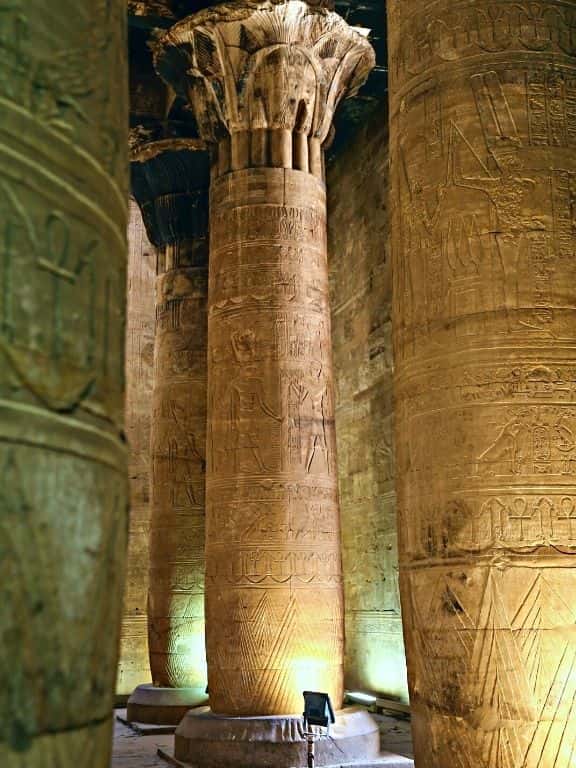
The Inner Hypostyle Hall / What to See at the Temple of Horus at Edfu
Adjacent to the Inner Hypostyle Hall, you will discover three small, intimate chambers, each a repository of history and ritual.
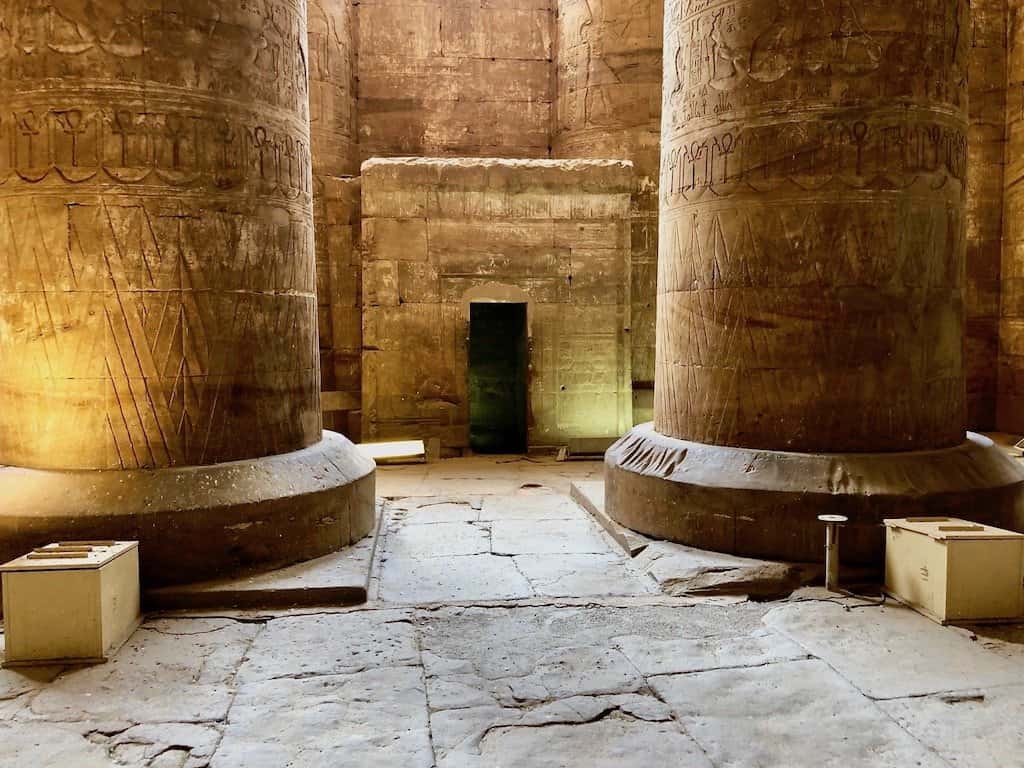
There are several small rooms adjacent to the hall / What to See at the Temple of Horus at Edfu
On the left, the Room of the Nile once stored the sacred waters essential for purification rituals, imbuing the temple’s sacred rites with the symbolic purity of the Nile River.
Beside it lies a chamber of particular intrigue – a room dedicated to the creation of perfumes used in temple rituals. Its walls are adorned with meticulous instructions, offering insight into the art of crafting scents that played a role in ancient religious ceremonies, a fragrant bridge to the divine.
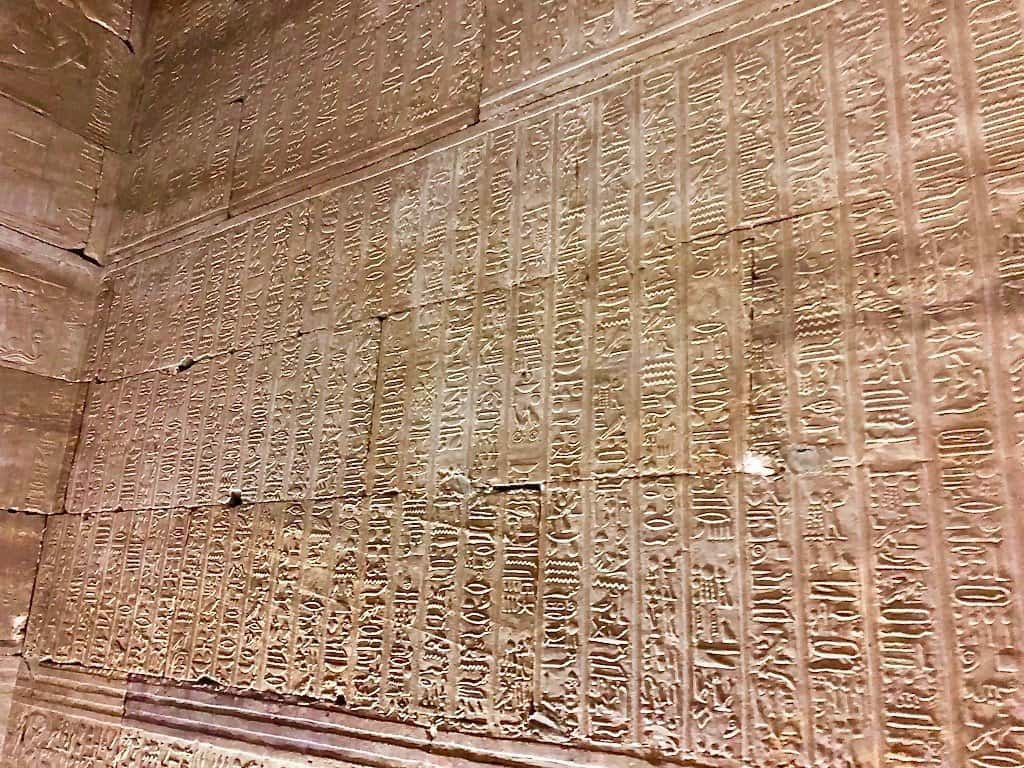
The walls of this room are covered with detailed instructions for obtaining different scents / What to See at the Temple of Horus at Edfu
To the right of the Inner Hypostyle Hall once stood the Treasury, a treasure trove housing precious objects used to adorn the statues of the gods. Each item within is a testament to the devotion and offerings made by ancient worshippers.
Continuing your journey, you’ll pass through the Hall of Offerings, a narrow room where food and oil offerings were ritually burned as tributes to the gods. Here, the air would have been filled with the sweet scent of offerings, symbolizing the devotion of the worshippers.
Beyond the Hall of Offerings awaits the Vestibule, also known as the Antechamber, marking the threshold to the temple’s most sacred precinct – the Naos.
With every step, you delve deeper into the heart of Edfu’s spiritual legacy, drawing closer to the pinnacle of its sacred mysteries.
The Naos
Now, let us step into the innermost sanctum of the Temple of Horus at Edfu, the Naos.
This shrine, regarded as the most ancient segment of the temple complex, was constructed by the pharaoh Nectanebo II. Within its hallowed confines, a profound piece of history awaits your discovery—a black monolithic block bearing the regal cartouche of Nectanebo II.
As my knowledgeable guide revealed to me, the Naos was not merely an architectural marvel but also served as a repository for sacred treasures.
Here, the revered sacred barks of Horus and Hathor, vessels used in solemn processions, found their resting place. Additionally, the Naos cradled a statue of Horus, a symbol of divine presence and devotion.
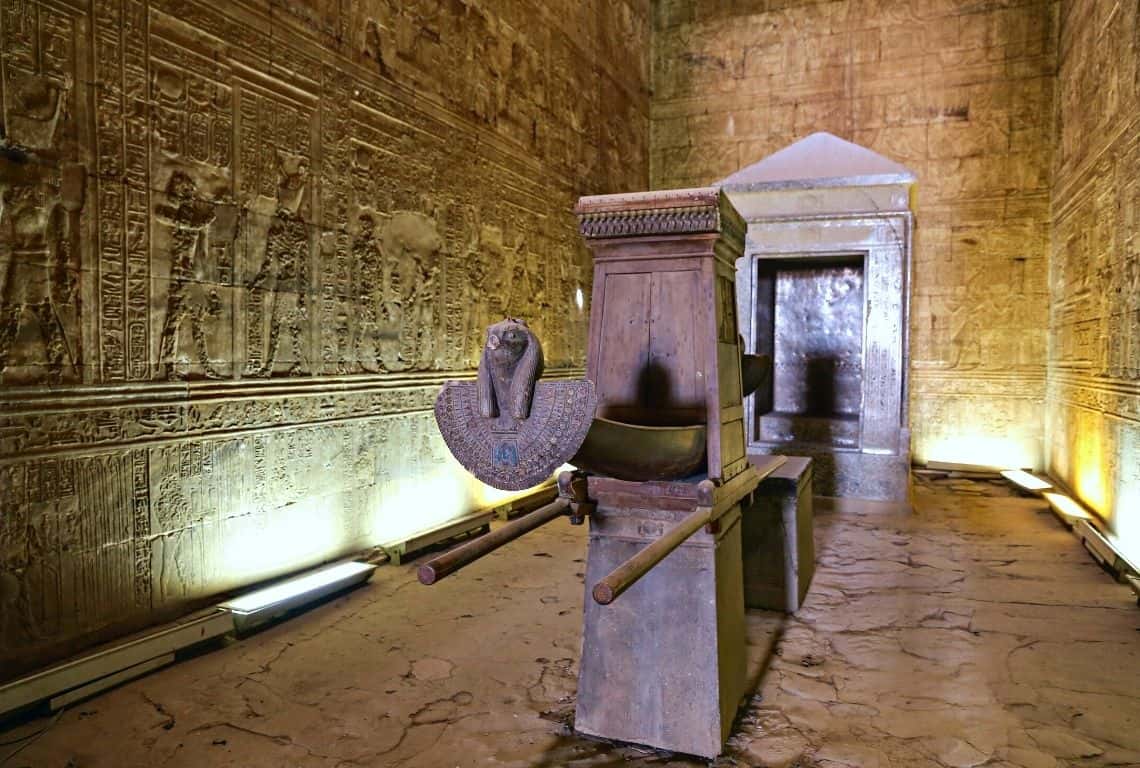
The Naos at the Temple of Horus at Edfu is the shrine built by Nectanebo II. It is the oldest part of the temple / What to See at the Temple of Horus at Edfu
Emerging from the Naos, allow yourself the luxury of unhurried exploration throughout the temple complex. The Temple of Horus at Edfu is a labyrinthine marvel, brimming with chambers, chapels, and storerooms that invite you to delve deeper into its rich tapestry of history and spirituality.
To the east, you will encounter chambers that once safeguarded precious metals and gemstones, attesting to the temple’s wealth and significance. In these chambers, ancient treasures were stored, awaiting their use in sacred rituals and ceremonies.
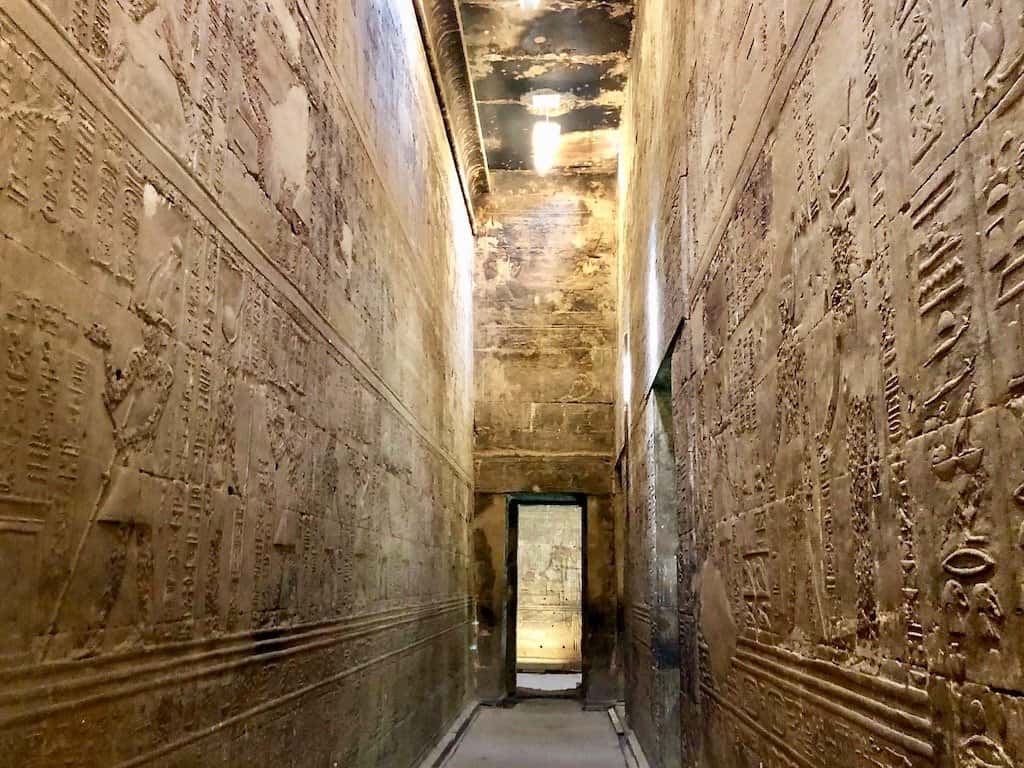
Take your time and wander around the temple. There are many rooms and passages surrounding the temple / What to See at the Temple of Horus at Edfu
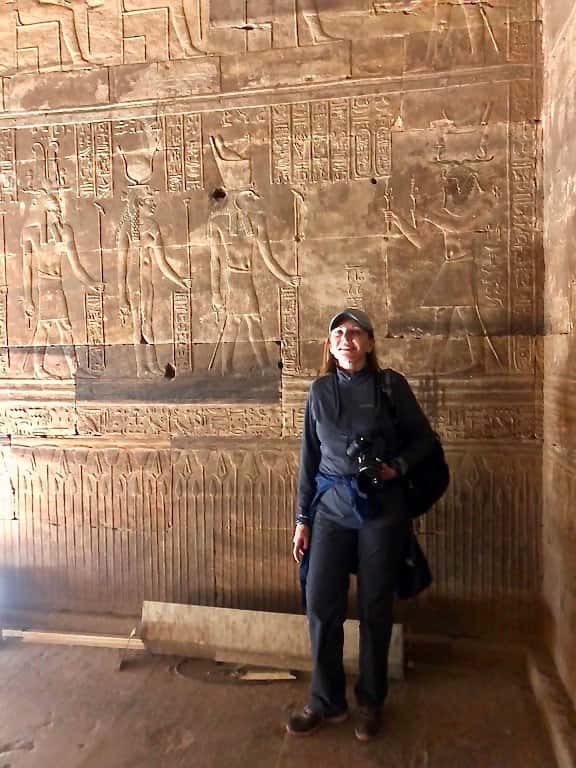
On the east side are chambers that served as storage for precious metals and stones / What to See at the Temple of Horus at Edfu
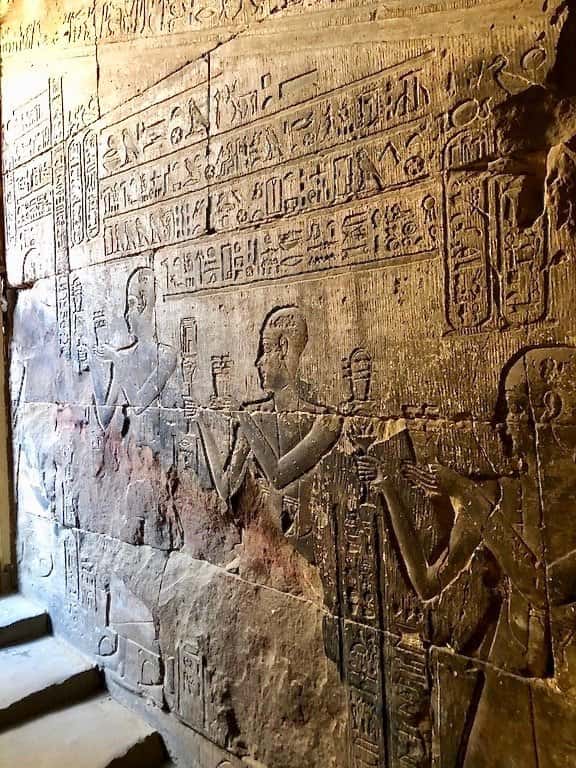
To the west are chambers that served as places for making sacred oils and ointments, with instructions on the walls / What to See at the Temple of Horus at Edfu
Conversely, to the west lie chambers that served as sanctuaries for the creation of sacred oils and ointments, replete with detailed instructions etched onto the walls.
These inscriptions offer insights into the intricate artistry and spiritual significance of the substances used in temple rites, providing a glimpse into the meticulous preparations that accompanied worship at Edfu.
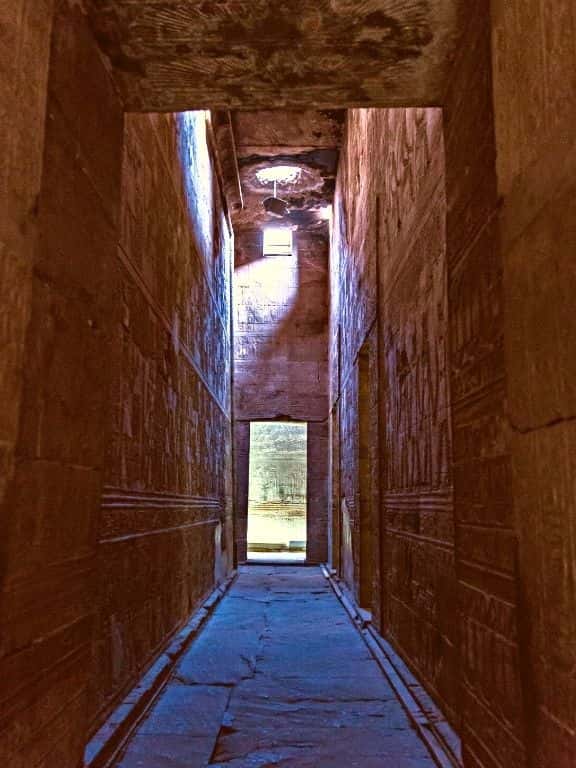
There are many chambers, chapels, and store rooms. It is really like a maze! / What to See at the Temple of Horus at Edfu
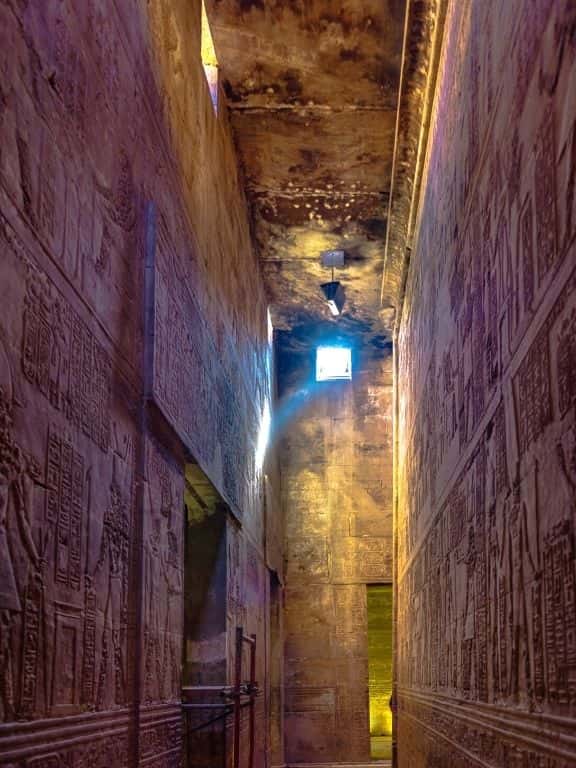
After you visit the Naos at the Temple of Horus at Edfu, take your time and wander around the temple / What to See at the Temple of Horus at Edfu
As you traverse these winding corridors and explore the myriad chambers, you will find yourself not only retracing the footsteps of ancient priests and worshippers but also connecting with the profound legacy of the Temple of Horus at Edfu, a sacred space that transcends the boundaries of time and culture.
You Might Also Like:
How to Visit and What to See at KHAN EL-KHALILI BAZAAR in Cairo
Perfect 7-Day Egypt Itinerary for First Visit (Cairo, Aswan, Luxor, Abu Simbel)
What to See at the TEMPLE of HORUS at EDFU (5 Things You Can’t Miss)
What to See at the TEMPLE of KOM OMBO, Egypt (9 Things You Can’t Miss)
How to Visit Abu Simbel: Everything You Need to Know to Plan Your Visit
How to Visit and What to See at the TEMPLE of PHILAE in Aswan
Best Day Trip from Cairo – Dahshur, Memphis, and Saqqara (Maps+Photos)
19 Must-See Things at Egyptian Museum in Cairo (+Practical Tips)
Did You Find What to See at the Temple of Horus at Edfu Useful?
Why not save it to your Pinterest board!
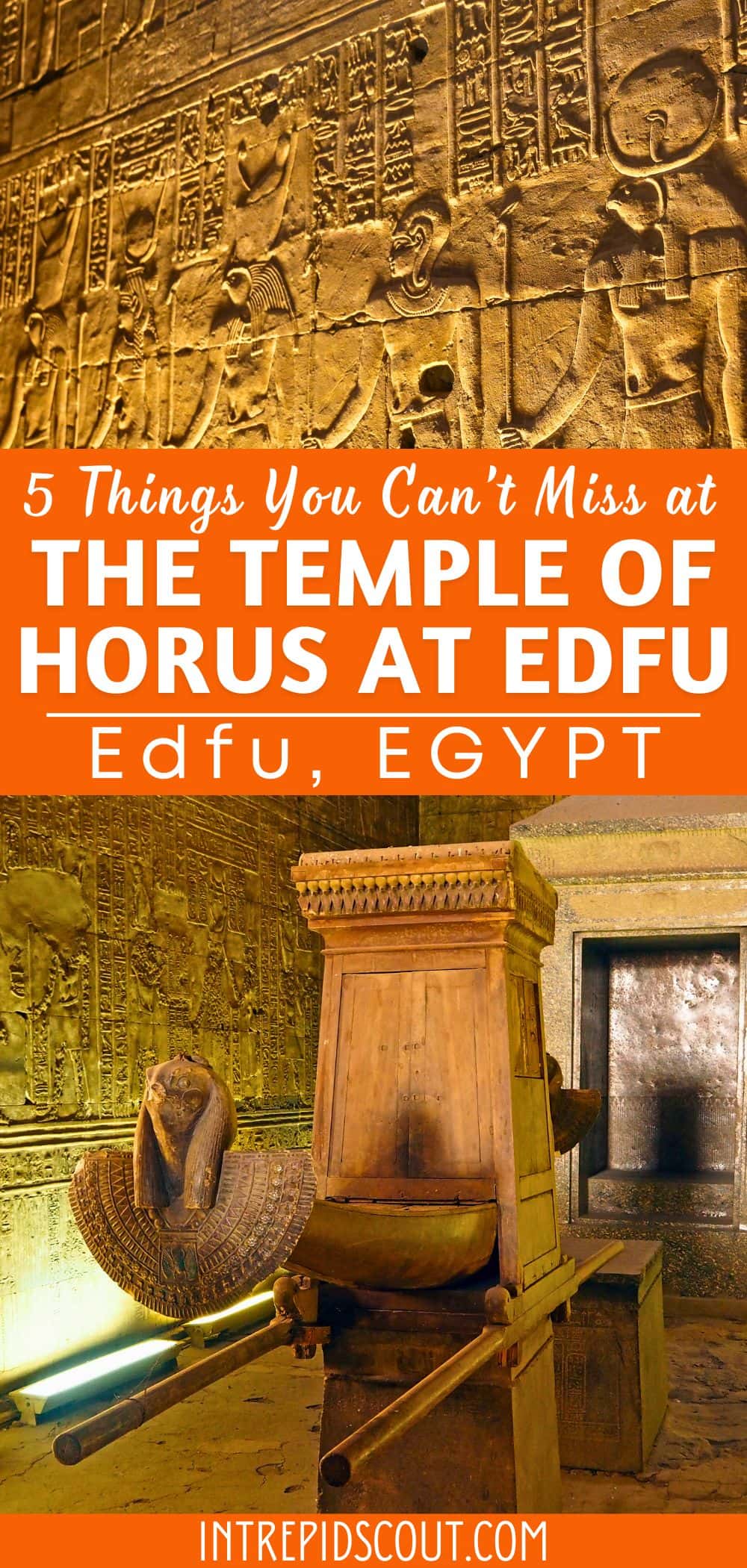
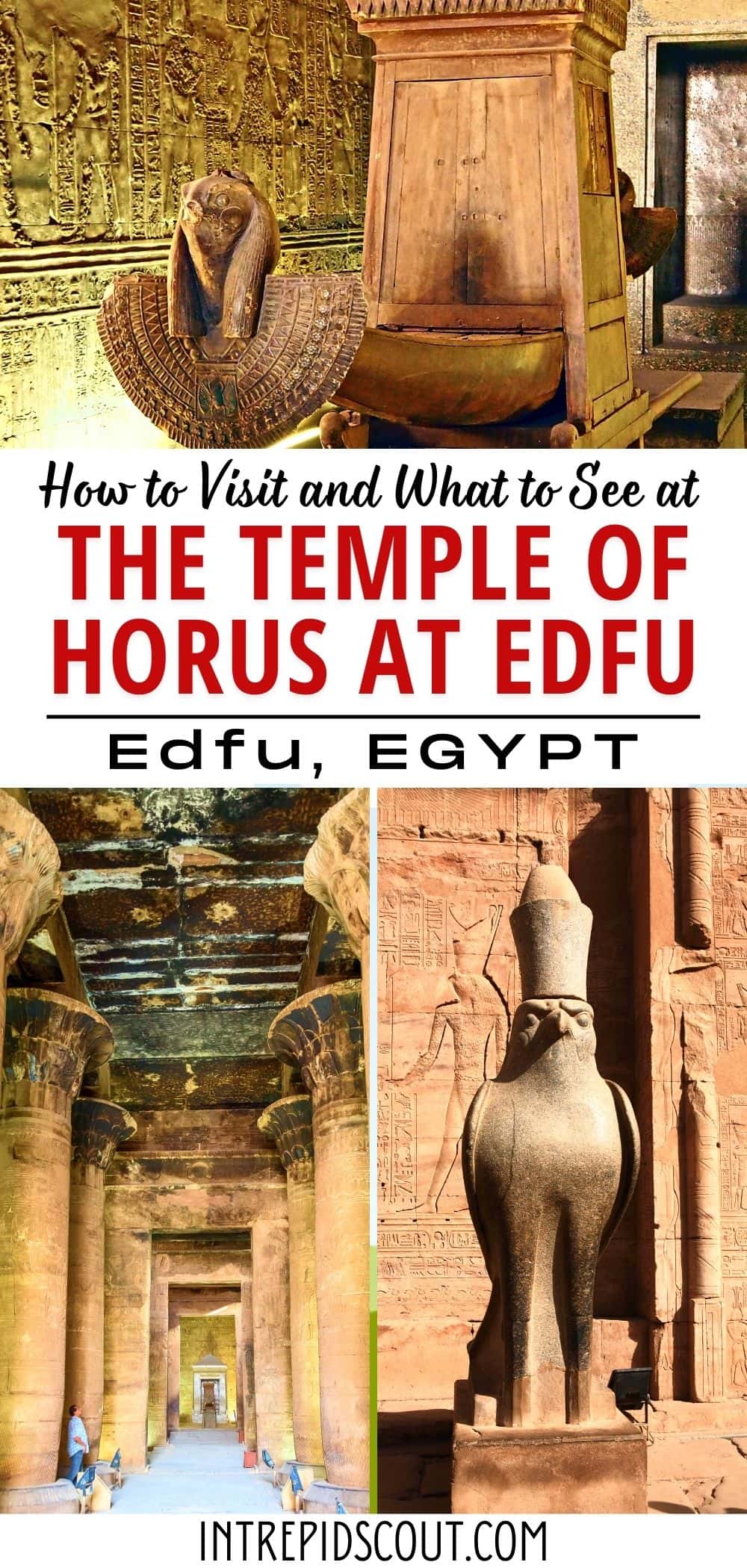
Now, It Is Your Turn, I Would Like to Hear Back from You!
Are you planning your trip to the Temple of Horus at Edfu?
Please let me know! Drop me a quick comment right below!
Click on any of the images below to get inspired and to help you with the planning process for your trip to Luxor or any other place in Egypt!
